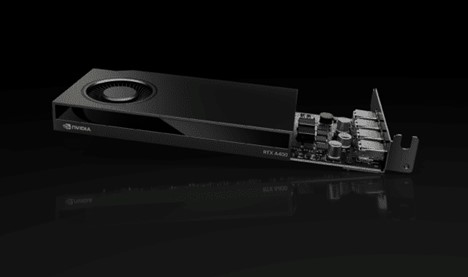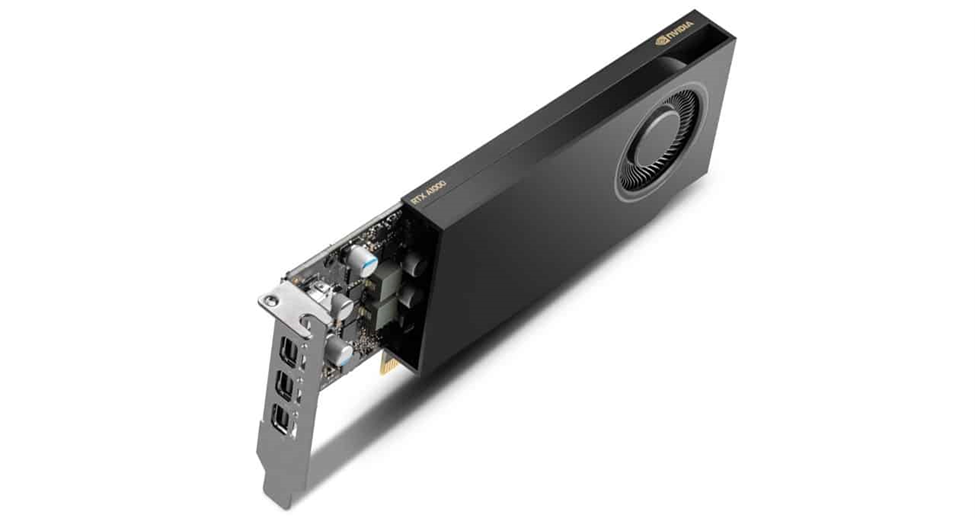Nvidia is offering two new Ampere-based desktop GPUs, the A1000 and A400, to boost AI-powered applications and design. The RTX A1000 has both Tensor cores and RT cores, a first for the RTX 1000 series. The RTX A400 also contains Tensor and RT cores, making accelerated ray tracing and AI available in the RTX 400 series AIBs for the first time.

What do we think? Application vendors are stepping things up when it comes to delivering AI-powered tools, and it is happening at lightning speed. Desktop users want to get the biggest advantage they can out of those apps. Nvidia is more than willing to give them the power they need with an AIB that can handle these demanding AI applications, even down at the desktop level, bringing real-time ray tracing and AI acceleration to this new set of users on low-profile machines.
Nvidia’s got the desktop AIB for you
As generative AI apps seep further into the fabric of our work life, the demand for more compute power on the desktop to handle those applications only gets stronger. To meet this growing need of professionals, Nvidia introduced a pair of new workstation add-in boards based on its Ampere architecture GPUs for desktops, the RTX A1000 and the RTX A400, bringing RTX features to this group of users. These are the first low-end professional AIBs for professionals that contain Tensor cores and RT cores.

A significant upgrade over the previous generation, the RTX A1000 has Tensor cores and the addition of RT cores for accelerated AI and ray-tracing performance—a first for the RTX 1000 series.
The A1000 has 8GB of GDDR6 memory, and with the addition of Tensor cores (there are 72) it delivers more than 3× generative AI processing over the T1000 for GenAI-augmented tools and applications, according to Nvidia, enabling capabilities like AI denoising and DLSS. And, its 18 RT cores accelerate graphics and rendering by up to 3× and ray tracing by 2× over the previous-generation AIB.

Nvidia said the AIB can also handle up to 38% more encode streams and achieve 2× faster decode over the previous generation. With the Ampere-based CUDA cores, graphics and compute workflows can be accelerated with up to 2× single-precision floating-point (FP32) performance compared to the previous generation, the company stated.
| Nvidia RTX A1000 | |
| Architecture | Ampere |
| Foundry | Samsung |
| Process size | 8n (Nvidia custom) |
| Transistors | 8.7 billion |
| Die size | 200mm2 |
| CUDA cores | 2,304 |
| Tensor cores | 72 |
| RT cores | 18 |
| Single-precision performance | 6.74 TFLOPS |
| RT-core performance | 13.2 TFLOPS |
| Tensor performance | 53.8 TFLOPS |
| GPU memory | 8GB GDDR6 |
| Memory interface | 128 bit |
| Memory bandwidth | 192 GB/sec |
| Graphics bus | PCI Express 4.0 x8 |
The A1000 is available now.
The RTX A400 marks the first time that real-time ray tracing and accelerated AI are available in the RTX 400 series AIBs. This enables creators to generate physically accurate 3D renders and professionals to run cutting-edge AI apps such as chatbots and copilots directly on their desktops.
The RTX A400 has 4GB of GDDR6 memory and contains 24 Tensor cores for AI processing, which Nvidia says is faster than what’s achievable with traditional CPU solutions. In another first for the series, the A400 also sports four display outputs, a feature that will be appreciated especially in industries like financial services, retail, and transportation.
The A400 is expected to be available from channel partners starting in May and from manufacturers this summer.
| Nvidia RTX A400 | |
| Architecture | Ampere |
| Foundry | Samsung |
| Process size | 8n (Nvidia custom) |
| Transistors | 8.7 billion |
| Die size | 200mm2 |
| CUDA cores | 768 |
| Tensor cores | 24 |
| RT cores | 6 |
| Single-precision performance | 2.7 TFLOPS |
| RT-core performance | 5.3 TFLOPS |
| Tensor performance | 21.7 TFLOPS |
| GPU memory | 4GB GDDR6 |
| Memory interface | 64 bit |
| Memory bandwidth | 96 GB/sec |
| Graphics bus | PCI Express 4.0 x8 |
Like the A1000, the A400 has a low-profile, single-slot design that fits into a range of workstation chassis. They have active cooling and use just 50W TDP.
Both AIBs have second-gen RT cores and third-gen Tensor cores, and their GPUs represent increased memory bandwidth over each previous generation for faster data processing and smoother handling of large datasets and scenes. The AIBs further feature seventh-generation encode (NVENC) and fifth-generation decode (NVDEC) plus AV1 decode support. Like the A400, the A1000 contains four Mini DisplayPort 1.4a outputs.